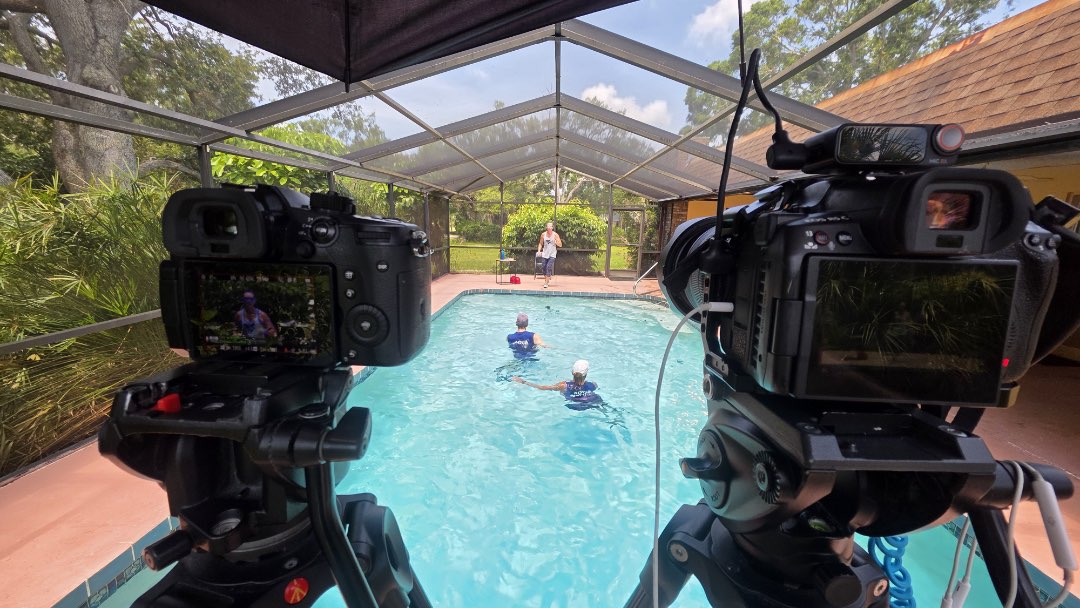Dispense a water exercise prescription to your class members that will help them get stronger and healthier. Strength & Power Rx with Dr. Lori Sherlock is a full hour aquatic fitness class format that focuses on strength and power and can be taught in both deep and shallow water. This aquatic fitness video includes on online course and quiz approved for 2.0 AEA CECs.
Doctors often ask if you exercise and for good reason. Countless studies over the years have proven that exercise is a critical factor in disease prevention and quality of life. Designed to help your class members move better, feel better and live better, the Strength & Power Rx class proves that aquatic exercise really is medicine. Known for her science-backed approach to designing aquatic fitness classes, Lori Sherlock, Ed.D. a professor in the School of Medicine at West Virginia University. Below, she talks about the class format and then read on to learn more about why strength and power is so important to aging bodies.
Why is Strength & Power so important?
By Dr. Lori Sherlock, Ed.D.
The declines in strength and power with age are a well-documented and significant aspect of the aging process, often referred to as sarcopenia (loss of muscle mass and strength) and dynapenia (loss of muscle strength, often disproportionate to muscle mass loss). These declines have profound effects on an individual's independence, quality of life, and overall function. Sarcopenia is formally defined as the age-related progressive loss of muscle mass, strength, and function. While muscle atrophy is a general term for muscle tissue loss, sarcopenia specifically refers to this age-related process. Some sources suggest a loss of up to 30% of muscle mass between ages 50 and 70, with the rate accelerating further after 70.
Power, which is the ability to generate force quickly, tends to decline earlier and at a faster rate than pure strength. Some studies suggest that physical performance, including power, can start to decline quietly from approximately age 35. After age 40, power can decline at almost twice the rate of strength. For example, every decade after 40, power might decline by 17% while strength declines by 10%. This means by age 70, an individual could have lost 30% of their strength but 51% of their power.
How These Declines Affect Independence, Quality of Life, and Overall Function
The cumulative effect of declining strength and power is a significant reduction in an individual's ability to perform daily tasks and maintain a high quality of life:
-
- Activities of Daily Living (ADLs): Simple tasks like getting out of a chair, climbing stairs, lifting groceries, bathing, or dressing become increasingly difficult and eventually impossible without assistance.
- Mobility: Reduced strength and power lead to slower walking speed, impaired balance, and an increased risk of falls.
- Fear of Falling: A fear of falling can lead to reduced physical activity, creating a vicious cycle of further muscle loss and increased fall risk.
- Social Isolation: Inability to participate in social activities, hobbies, or community events due to physical limitations.
- Mental Health: Loss of independence and physical capabilities can lead to feelings of frustration, anxiety, and depression.
- Increased Pain: Weaker muscles can lead to joint instability and increased strain, contributing to chronic pain.
- Metabolic Health: Less muscle mass can negatively impact metabolism, making weight management harder and increasing the risk of conditions like type 2 diabetes and cardiovascular disease.
- Increased Frailty: Sarcopenia and dynapenia are major components of frailty, a syndrome characterized by increased vulnerability to stressors, poor health outcomes, and a higher risk of hospitalization and death.
- Higher Fall Risk and Fractures: Weak muscles and poor balance significantly increase the likelihood of falls, which can result in serious injuries like hip fractures, leading to prolonged recovery, loss of independence, and even mortality.
- Difficulty Recovering from Illness/Injury: Individuals with lower strength and muscle mass have a harder time recovering from acute illnesses, surgeries, or injuries, as their body has less reserve to draw upon.
Clearly, the loss of strength and power can impact quality of life and longevity. But the good news is that exercise is medicine, and you can prevent and even reverse the loss of strength and over. Strength and Power Rx is a water workout that can do just that.
Strength & Power RX: Class-at-a-Glance
This aquatic fitness class can be taught in either deep or shallow water and includes a warm-up, cool down and 7 exercise segments. Drag equipment, such as the Hydrorevolution Upper Body Drag Resistance or webbed gloves can be used in some of the segments, but equipment is not required. Below is a brief summary of the exercise segments.
Exercise Segments 1 and 2: Strength & Power
These two segments alternate exercises with a strength focus and a power focus.
Exercise Segment 3: Upper Body AMRAP
AMRAP stands for “as many reps as possible,” and in this segment 5 exercises are repeated in a loop for a continuous 6 minutes.
Exercise Segment 4: Reps & Sets
This segment more closely resembles strength training in the gym, wth fewer reps repeated for several sets.
Exercise Segment 5: Tabata
Designed for strength and power, 4 exercises are repeated twice for 20 seconds of maximum energy, followed by 10 seconds of rest.
Exercise Segments 6 & &: Strength & Cardio
These two segments alternate exercises with a strength focus and a cardio focus.
-------------------------------
Fitmotivation extends gratitude to Lori for sharing her extensive knowledge and passion with subscribers. Knowledge is power. Educated instructors are the best instructors. Check out Lori’s bio and other Fitmotivation videos and stay tuned for a couple more videos with Lori posting this fall.
